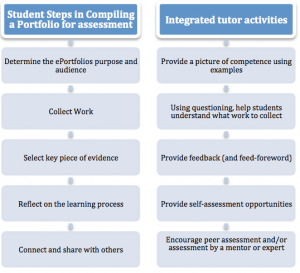Meeting Summary
During the Portfolio CoP meeting held on November 7, we explored approaches to assessing ePortfolios. As part of this discussion and sharing session Bernie Garret Associate Professor in the School of Nursing and Andrea Webb instructor in the Faculty Certificate Program discussed approaches that they have taken to assess portfolios and ePortfolios.
Andrea Webb discussed how ePorfolios are assessed in the Faculty Certificate Program (FCP). The faculty certificate program is a one-year program focused offered for faculty leaders at the University of British Columbia. As part of this program participants develop a learning portfolio using the Connect Wiki tool, which is used to showcase and assess their learning. The program has adopted moved the learning portfolio online recently and Andrea discussed some of the assessment strategies used in the program.
- Various formative and summative check-in that provide participant feedback on their portfolios
- Peer review: Each participant has their ePortfolio assessed by a peer early in the program schedule. This peer review provides the participants with a low-stake opportunity to receive feedback and make changes to their ePortfolio
- Formative check-in: A formative check in with course instructors.
- Summative check-in: For the final summative check in faculty ePortfolios are evaluated external reviewers (Past program participants)
Bernie Garrett, discussed different ways that ePortfolios are used in the school of nursing and the different approaches and strategies used to assess them. The PEP Portfolio was developed to assess the clinical skills of undergraduate nursing students. The PEP includes functionality to allow clinical supervisors to assess clinical skills through observation. It also allows students to create learning plans, and reflect using learning journals.
Bernie Garrett also discussed graduate nursing ePortfolios that are developed using the Blackboard Learning management system using the built in blog tools. He noted that with these ePortfolios he used formative and summative check ins.
This lead to further discussion around approaches and strategies for assessing ePortfolios with a number of suggestions made by the group including:
- Considerations in determining the extent that ePortfolio artifacts are selected by students or our mandated by the institution or program.
- It was noted that that highly structured ePortfolios are effective at providing valid assessment and for gathering data about student learning, however they tend to take away from the ownership and creative ways that students can create artifacts and develop their ePortfolios.
- ePortfolios projects that allow students more ownership and flexibility in developing their ePortfolios has limitations for valid assessment in some context, but provides students more opportunities for creativity etc
- The lack of clarity around ePortfolio definitions makes it challenging to implement ePortfolio projects and that part of the work in implementing ePortfolios needs to clarify the purpose of creating an ePortfolio
- Faculty and student buy-in is a key component of successful ePortfolio implementation. We discussed different approaches to getting this buy-in, including explicitly discussing the learning gains for students in developing an ePortfolio
Resources
Practice Portfolio Demonstration Site
Login and try out the PEP
Dekker, H., Driessen E.W., Braak, E.W. ter, Scheele, F., Slaets, J.P., Molen, T. van der & Cohen-Schotanus, J. (2009) Mentoring portfolio use in undergraduate and postgraduate medical education. Medical Teacher. 31:903-909
Garrett, B. M., & Jackson, C. (2006). A mobile clinical e-portfolio for nursing and medical students, Nurse Education in Practice, 6, 339–346. Retrieved from
Garrett, B., MacPhee, M., Jackson, C. (2012) Evaluation of an ePortfolio for the assessment of clinical competence in a baccalaureate nursing program, Nursing Education Today. Vol 33, Issue 10. Retrieved from
Tartwijk, J. van & Driessen, E. W. (2009) Portfolios for assessment and learning: AMEE guide no. 45 Medical Teacher. 31: 790-801.

